Flowers have always been a key part of human culture, from ornamental gardens to special occasions and symbolic meanings. Learning different types of flowers and understanding their significance not only enhances your vocabulary but also gives insight into various traditions, gardening, and flower arrangements.
In this blog post, we’ll explore flower names with pictures, providing a comprehensive list of flowers with their characteristics, symbolism, and gardening tips. Whether you’re a gardener, a florist, or just a flower lover, this guide will give you all the information you need to become familiar with 100 flowers names and beyond.
Popular Flowers Names in English
Flowers have universal appeal, but some are more recognized than others. Here are some of the most common flowers you’re likely to encounter, along with some useful facts:
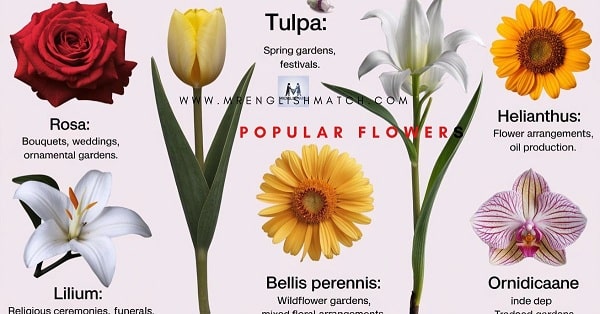
- Rose
Roses come in a variety of colors, each with its own symbolism. Red roses symbolize love, yellow for friendship, and white for peace.
Scientific Name: Rosa
Common Use: Bouquets, weddings, ornamental gardens. - Tulip
Tulips are associated with spring and renewal. They come in nearly every color imaginable, making them a favorite for decorative displays.
Scientific Name: Tulipa
Common Use: Spring gardens, festivals. - Sunflower
Known for its cheerful appearance, the sunflower symbolizes adoration and loyalty.
Scientific Name: Helianthus
Common Use: Flower arrangements, oil production. - Lily
Lilies are symbols of purity and refined beauty.
Scientific Name: Lilium
Common Use: Bouquets, religious ceremonies, funerals. - Daisy
Daisies are simple, cheerful flowers that symbolize innocence and purity.
Scientific Name: Bellis perennis
Common Use: Wildflower gardens, mixed floral arrangements. - Orchid
Orchids represent luxury, beauty, and strength. They are one of the largest families of flowering plants.
Scientific Name: Orchidaceae
Common Use: Indoor decor, tropical gardens.
you might also like:
Pet Animal Names and their nicknames
Flower Categories
types of Flowers Categorized by Season
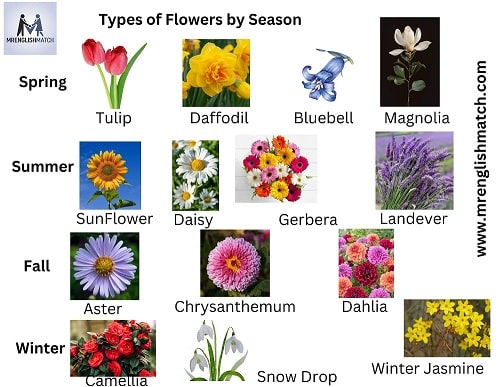
| Season | Flower Name | Description |
| Spring | Tulip | Bright, cup-shaped blooms, classic spring flower |
| Daffodil | Yellow flowers symbolizing rebirth | |
| Bluebell | Bell-shaped flowers, typically blue | |
| Magnolia | Large, fragrant blooms, symbol of the South | |
| Summer | Sunflower | Tall, bright yellow, follows the sun |
| Daisy | Simple white petals, yellow center | |
| Gerbera | Colorful, daisy-like appearance, common in bouquets | |
| Lavender | Fragrant, purple flowers, blooms in early summer | |
| Fall | Chrysanthemum | Classic fall bloom, represents longevity |
| Aster | Star-shaped flowers that bloom in late summer/fall | |
| Dahlia | Large, multi-petal blooms in various colors | |
| Winter | Camellia | Rose-like flowers with glossy leaves |
| Snowdrop | White, bell-shaped flowers, blooms in the snow | |
| Winter Jasmine | Yellow flowers that bloom in cold winter months |
Flower types Categorized by Habitat
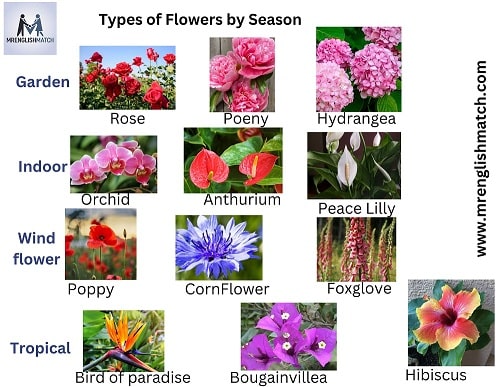
| Habitat | Flower Name | Description |
| Garden | Rose | Classic ornamental flower, variety of colors |
| Peony | Large, fragrant blooms, great for beds and borders | |
| Hydrangea | Large, round flower clusters, changes color with soil pH | |
| Indoor | Orchid | Exotic flowers, low-maintenance, perfect for indoors |
| Anthurium | Glossy, heart-shaped flowers, common houseplant | |
| Peace Lily | Low-light houseplant, known for air purification | |
| Wildflower | Poppy | Bright red, associated with remembrance |
| Cornflower | Brilliant blue, often grows wild in meadows | |
| Foxglove | Tall spires of bell-shaped flowers, thrives in the wild | |
| Tropical | Bird of Paradise | Exotic-looking, resembles a tropical bird |
| Bougainvillea | Vibrant, papery blooms, thrives in warm climates | |
| Hibiscus | Large, colorful blooms, commonly found in the tropics |
Flowers Categorized by Use
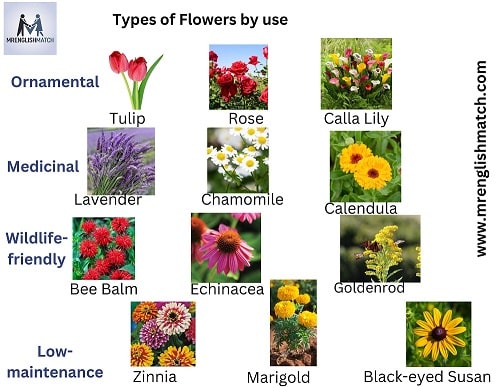
| Use | Flower Name | Description |
| Ornamental | Tulip | Classic spring decoration, bright and colorful |
| Rose | Used in gardens, bouquets, and decor | |
| Calla Lily | Elegant, often used in wedding arrangements | |
| Medicinal | Lavender | Known for its calming, healing properties |
| Chamomile | Popular for calming teas and herbal remedies | |
| Calendula | Used in skin ointments for its healing properties | |
| Wildlife-friendly | Bee Balm | Attracts bees, butterflies, and hummingbirds |
| Echinacea (Coneflower) | Hardy perennial, loved by pollinators | |
| Goldenrod | Provides nectar for bees and butterflies | |
| Low-maintenance | Zinnia | Drought-tolerant, perfect for beginner gardeners |
| Marigold | Easy to grow, pest-resistant, blooms all summer | |
| Black-eyed Susan | Drought-resistant, thrives in poor soils |
Rare Types of Flowers
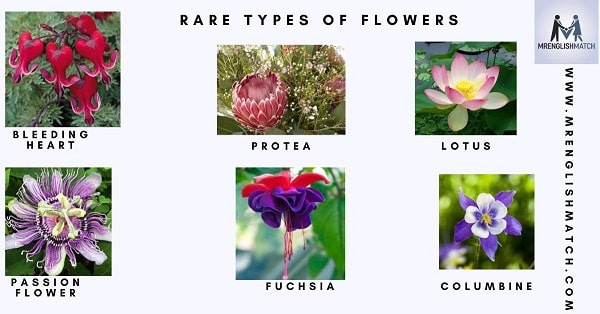
| Flower Name | Description |
| Bleeding Heart | Heart-shaped flowers that hang delicately from stems |
| Protea | Large, showy tropical flowers with unique textures |
| Lotus | Symbol of purity, grows in water, exotic blooms |
| Passion Flower | Intricate, unusual flowers with a striking design |
| Fuchsia | Drooping, bell-shaped flowers in vivid colors |
| Columbine | Unique, spurred petals, thrives in cooler climates |
Identification: Flower types by Petal Shape & Color

| Flower Name | Description |
| Rose | Classic spiral petal structure, layered |
| Daisy | Simple, radial white petals, yellow center |
| Lily | Large, trumpet-shaped flowers, various colors |
| Iris | Sword-like leaves, six petals in varying colors |
| Carnation | Ruffled petals, available in many vibrant hues |
| Calla Lily | Smooth, elegant flowers with a trumpet shape |
This arrangement provides a comprehensive guide based on flower seasonality, habitat, uses, and rarity, helping users easily identify and choose flowers for their gardening, decor, or personal interests.
Different Types of Flowers with Their Pictures
Here’s a curated list of flowers, each with a brief description and image to help you identify them easily.
| Flower Name | Description |
| Aster | Perennial, daisy-like flower. |
| Zinnia | Brightly colored annuals. |
| Snapdragon | Tall, spiky flowers. |
| Freesia | Fragrant, trumpet-shaped. |
| Ranunculus | Multilayered, rose-like petals. |
100 flowers names with pictures can be an excellent reference for those interested in flower identification. Including both common flower names and rare species gives you a well-rounded knowledge base for recognizing various flowers in gardens, shops, or even wild settings.
Flower Meanings and Symbolism
Flowers are not just about beauty; they carry profound meanings and symbolism. Below are some examples:
- Lavender: Represents serenity and purity. Often used in aromatherapy for relaxation.
- Rose: Different colors signify different emotions. For instance, red is for love, and white symbolizes innocence.
- Daffodil: A symbol of rebirth and new beginnings, often associated with spring.
Flowers have played a symbolic role in human history, and flower meanings and symbolism are still widely used today in ceremonies, gifts, and decorations. For example, weddings often feature flowers with positive meanings like purity (lilies) and loyalty (sunflowers).
Non conventional and Rare Flowers
For flower enthusiasts who crave something unique, rare flowers with names offer a glimpse into the extraordinary world of blooms. Some examples include:
- Bird of Paradise: Known for its striking resemblance to a tropical bird.
- Bleeding Heart: Delicate, heart-shaped flowers that droop gracefully from arching stems.
- Protea: A large, tropical flower that symbolizes transformation and courage.
Rare flowers are often harder to find but can make a bold statement in any arrangement or garden. Understanding how to care for them is crucial as they may require specific conditions.
Flowers for Different Gardening Types
When choosing flowers for your garden, it’s essential to match the flowers to the type of garden you have.
- Full-Sun Gardens: Flowers that need direct sunlight include Sunflowers, Lavender, and Daisies.
- Shade Gardens: For shaded areas, try Bleeding Heart, Hosta, or Ferns.
- Low-Maintenance Gardens: Ideal flowers include Marigold, Zinnia, and Coneflower—they require minimal attention but deliver great results.
Gardeners looking for practical advice can also refer to a flower identification guide to understand how to choose plants based on their local climate and garden conditions.
Flower Identification Guide
Identifying flowers can sometimes be tricky, especially if you’re new to gardening or floral arrangements. Here’s a quick guide to help you get started:
- Petal Shape and Size: One of the easiest ways to identify a flower. For example, Roses have a classic layered petal structure, while Daisies have long, slender petals.
- Leaf Shape: Flowers like the Iris have distinctive, sword-like leaves, while Orchids feature thick, leathery leaves.
- Color Patterns: Some flowers, like Tulips, come in multiple colors. Understanding these patterns helps distinguish between species.
Using a flower identification with pictures guide can make it much easier to recognize and categorize flowers, particularly for beginner gardeners or those learning about flower species.
Conclusion
In this comprehensive guide, we’ve covered different types of flowers, from common flower names to rare varieties. Whether you are planning a new garden, curious about flower meanings, or just expanding your vocabulary, learning flower names with pictures is an engaging and visually appealing way to enhance your knowledge. Use this guide as a reference to make informed choices about your garden, floral arrangements, or simply enjoy the beauty that flowers bring into our world.

John Robert is a seasoned grammar enthusiast and the insightful voice behind MrEnglishMatch. With years of experience in language arts and a passion for clear, effective communication, John’s blog posts blend expertise with approachable advice. His deep understanding of grammar and style helps readers sharpen their writing skills and master the nuances of English. When not blogging, John enjoys exploring new languages and reading classic literature.







